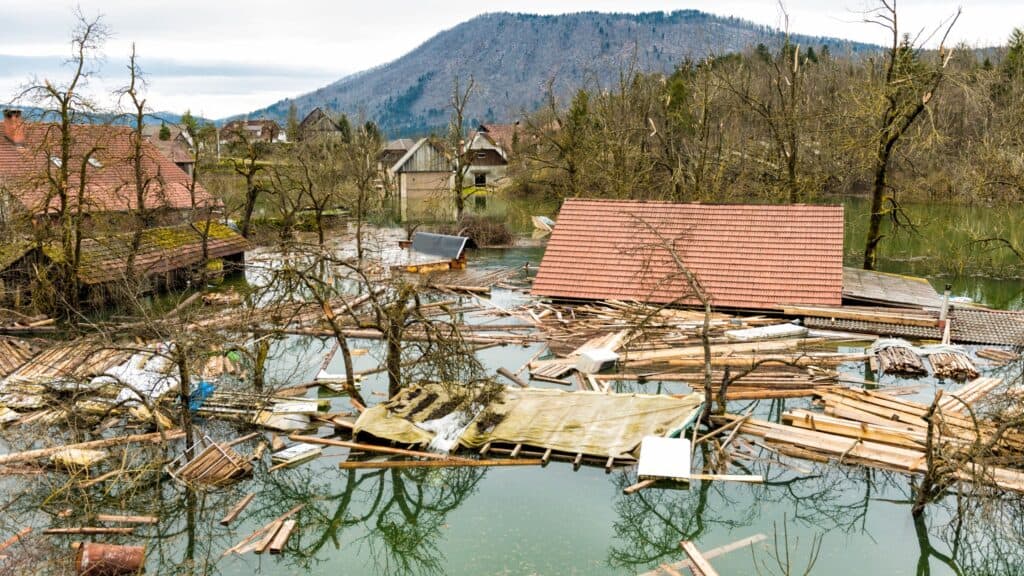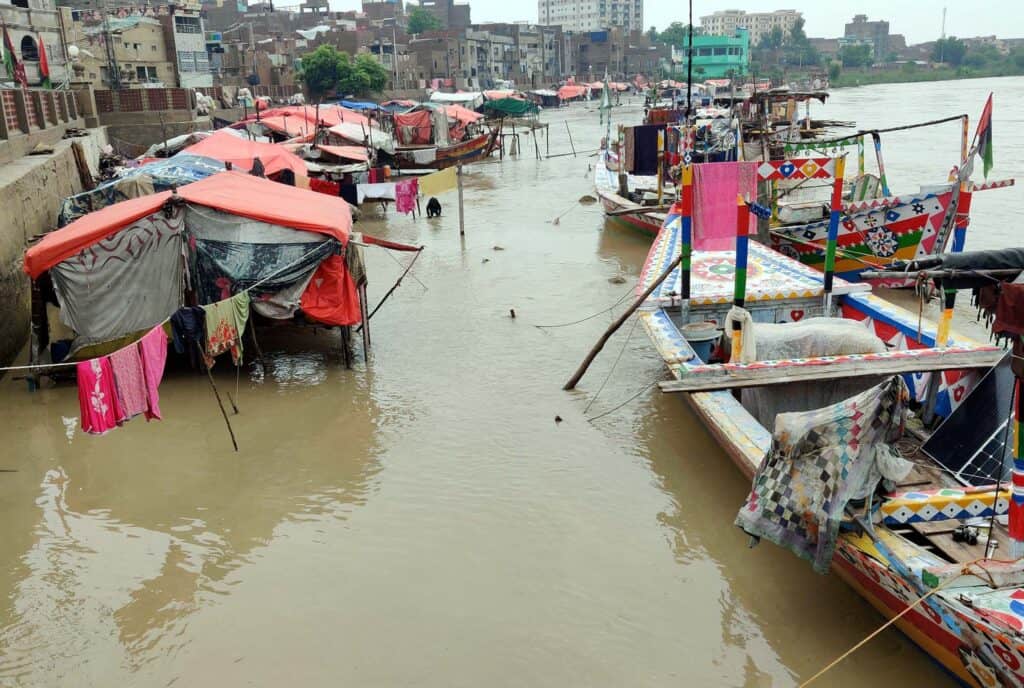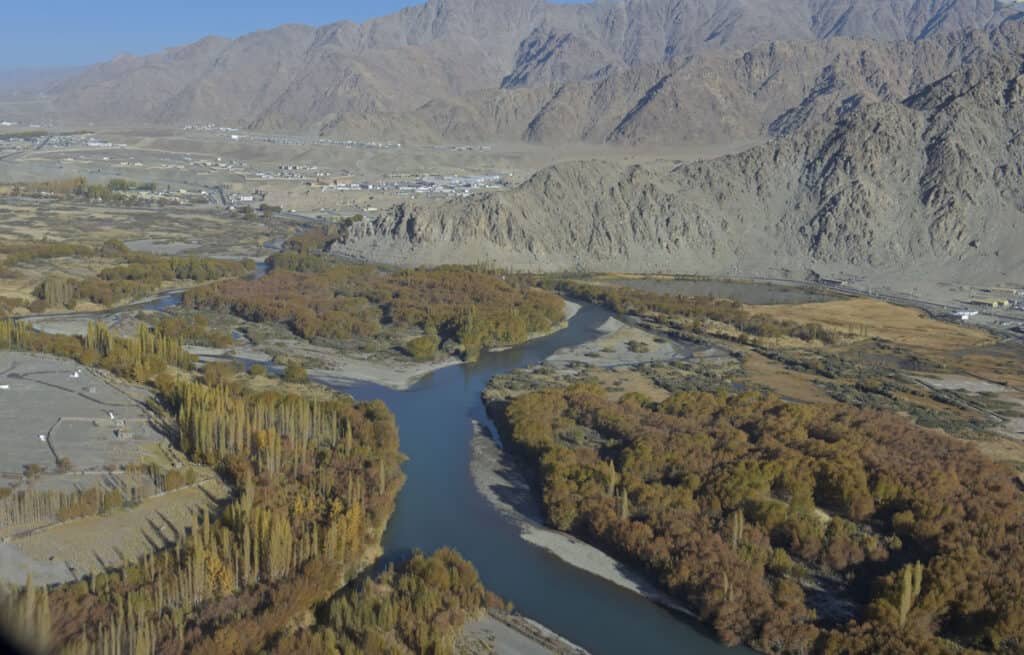Pakistan is a beautiful country with a wide variety of ecosystems. It spans from the Arabian Sea to the Karakoram Mountains in the north of the country. Even though it is just about twice the size of the state of California, it has a population of over 240 million people. Over 30 million of those people have been affected by floods that are being called apocalyptic by meteorologists, those on the ground in Pakistan, and people watching the situation from all around the world.
The sights are indeed catastrophic: fields with cows nearly covered by water, just their heads sticking up for air; large buildings crumbling into the water; a sea-sized lake where a normal river once flowed; water flowing over highways; people huddled in makeshift camps by the side of the road because they can’t go back home and have nowhere else to go; others wading through knee and waist deep waters to try to go about their lives.
What Has Led to the Flood in Pakistan?
Parts of the country have received non-stop rain for nearly two months. Some provinces, including Sindh and Balochistan, have seen 500% more rain than average. Karachi, the largest city in Pakistan, typically has a desert environment and receives around 10 inches of rain per year. This year it has received 48 inches. This is the wettest year on record since 1961. Lakes, rivers, canals, and other bodies of water have overflowed their banks.
The intense rain is caused by climate change, according to many scientists. Climate change causes higher air and sea temperatures. Warmer air can hold more moisture, creating more rain in areas that have monsoon seasons, such as Pakistan. The country is also highly affected by climate change due to the fact that it has the most glacial ice of any country. The only places that have more are the North and South Poles which are not part of any country. The mountainous region in the north of Pakistan is sometimes called “the third pole” due to this. These glaciers are melting quickly, adding to lakes and making them more full than usual, to begin with.

Flooding in Pakistan has had a devastating effect on those who live in the flood zones.
©Saigh Anees/Shutterstock.com
Why Are These Floods So Devastating?
Experts say that even a more developed country would be highly affected by floods such as these. They cite recent examples of flooding in Germany, Belgium, and Kentucky in the United States. However, they cite that many areas of Pakistan have less flood infrastructure, and have people who are already living in less developed conditions. Some say it is unfair that many of the people who are being most affected by climate change in Pakistan are those who are already living with few resources and have virtually no carbon footprint.
A young climate activist from Balochistan, Yusuf Baluch, told the BBC that even within Pakistan, economic inequality leads to differences in safety from climate disasters. He stated that wealthier people living in cities are less affected by the flooding than those with less privilege living in villages. He also said that it makes sense locals are angry that corporations are still in the area to extract fossil fuels while the people of the area no longer have a home and are struggling for the most basic necessities after the flooding.

Those who live with less privilege often endure the worst of the flooding.
©Asianet-Pakistan/Shutterstock.com
What Bodies of Water Are Flooding in Pakistan?
Perhaps most devastating, the Indus River has turned from a reasonable river into a 60-mile wide lake or sea. The river starts in the Western Tibetan mountains and flows through Pakistan before dumping into the Arabian Sea at Karachi. The river is incredibly important for the region. It provides much of the drinking water for the country and supports industries and agriculture. While it is common for the river to flood during the monsoon season which falls between July and September, a flood of this magnitude is unprecedented.
Another huge body of water that is contributing to the flooding is Manchar Lake in Sindh Province. It is Pakistan’s largest lake. It has already overflowed three times. Two of those were controlled releases to protect densely populated areas surrounding the lake. However, the controlled releases intentionally flooded around 400 smaller villages, affecting more than 100,000 people. People were told to evacuate ahead of the flooding, but many didn’t. They either did not have the resources, had nowhere else to go, or did not want to leave their livestock and their livelihoods. People in some of these villages say they had no warning.

The Indus River is is known to flood during monsoon season.
©iStock.com/Naresh Sharma
Despite the purposeful breaches, the lake levels remained dangerously high and the lake breached its walls a few days later. What makes this devastating is that Sindh Province produces around 50% of Pakistan’s food supply. With entire fields flooded, a lower-than-usual yield is expected this year. This could affect the entire country’s food supply for the year.
Residents of the Dadu district flooded by Manchar Lake say that authorities should have purposely breached the lake days before they did to empty water away from the populated area. This could have prevented the area, which has a population of over 1.5 million people, from becoming flooded. With roads blocked and flooded, people are trapped. No one can get in to rescue those trapped, and the trapped people have no way out.
What Are The Effects of the Flooding in Pakistan?
Overall, the intense flooding has killed more than 1,000 people, with more than 400 of the deaths being children. 1 million homes have been destroyed. Experts state that quite literally 1/3 of the country of Pakistan is currently underwater. Over 3000 miles of roads have been damaged or are not currently passable. Half a million people are currently sheltering in special camps for the displaced. Others are just sleeping on the side of the road. People whose homes were not destroyed are afraid to go back because they fear the damage to the building from the floods could cause it to collapse.
Some people have received governmental aid, but the magnitude of the crisis has left many without help. In some of the worst affected cities, 5-10% of people remain in their homes. They get around by swimming in the greenish sewage-laden waters, with a stick to guide them. Some have boats or makeshift watercraft.
Before this flood, Pakistan was already having economic issues. Prices of energy and food were already high. Their currency, the Pakistani Rupee, had lost value in the global market. This flood will likely cost at least $10 billion in damages, and it is not over yet.
Rescue Efforts for Pakistan
With some areas having little in the way of official rescue efforts, due to overwhelmed governmental and NGO resources, neighbors are helping neighbors. The head of one NGO said that despite great efforts, local NGOs and the government have only been able to reach around 10% of the people who needed help. One medical student who tried to set up a medical camp soon had to shut it down due to a lack of resources. People living in camps or staying on the side of the road say they have little to no food, no safe or clean drinking water, no medicine, and no resources in sight. Experts say that those who have survived the floods may soon be at risk of death from starvation and diseases due to tainted water and lack of available medicine.
While the country only produces 1% of the world’s greenhouse gas emissions, Pakistan is uniquely vulnerable to more intense weather from climate change due to its climate and geography. Because of this, the UN, which has committed $160 million for relief efforts, is calling for an international solution to this issue. They state that because the cause of the crisis is global, the solution should also be a global effort.
Up Next:
- Watch An Enormous Flash Flood Form In an Instant, Carrying Thousands of Trees
- Discover the Biblical Flood that Created Today’s Mediterranean Sea
- Must See: Yellowstone National Park’s Devastating Flooding
- The Most Devastating Natural Disasters on Earth and the Damage They Caused
The photo featured at the top of this post is © Asianet-Pakistan/Shutterstock.com
Sources
- Shah Meer Baloch, Available here: https://www.theguardian.com/world/2022/sep/06/we-screamed-our-hearts-out-for-help-homeless-escape-pakistan-floods
- Pumza Fihlani in Islamabad & Simon Fraser in London, Available here: https://www.bbc.com/news/world-asia-62764224
- Gerry Shih, Shaiq Hussain and Andrew Jeong, Available here: https://www.washingtonpost.com/world/2022/08/30/pakistan-flooding-underwater-monsoon/
- Kathleen Magramo, Available here: https://www.cnn.com/2022/09/02/asia/pakistan-floods-climate-explainer-intl-hnk
- Susannah George, Available here: https://www.washingtonpost.com/world/2022/09/06/pakistan-flooding-manchar-lake/
- Javed Iqbal, Sameer Mandhro and Kathleen Magramo, Available here: https://www.cnn.com/2022/09/07/asia/pakistan-flood-lake-manchar-swells-intl-hnk/index.html
- Georgina Rannard, Available here: https://www.bbc.com/news/science-environment-62758811
FAQs (Frequently Asked Questions)
How many people have been affected by the floods in Pakistan?
About 33 million people have been affected by flooding in Pakistan in 2022.
What led to the floods in Pakistan?
Parts of the country have received non-stop rain for nearly two months. The intense rain is caused by climate change, according to many scientists. Climate change causes higher air and sea temperatures. Warmer air can hold more moisture, creating more rain in areas that have monsoon seasons, such as Pakistan. The country is also highly affected by climate change due to the fact that it has the most glacial ice of any country. These glaciers are melting quickly, adding to lakes and making them more full than usual, to begin with.
What bodies of water are flooding in Pakistan?
The Indus River has turned from a reasonable river into a 60-mile wide lake or sea. Another huge body of water that is contributing to the flooding is Manchar Lake in Sindh Province.
What is Pakistan's largest lake?
Manchar Lake is Pakistan’s largest lake.
What are the effects of flooding in Pakistan?
Overall the intense flooding has killed more than 1,000 people, with more than 400 of the deaths being children. 1 million homes have been destroyed. Experts state that quite literally 1/3 of the country of Pakistan is currently underwater. Over 3000 miles of roads have been damaged or are not currently passable. Half a million people are currently sheltering in special camps for the displaced. Others are just sleeping on the side of the road. People whose homes were not destroyed are afraid to go back because they fear the damage to the building from the floods could cause it to collapse.
Before this flood, Pakistan was already having economic issues. Prices of energy and food were already high. Their currency, the Pakistani Rupee, had lost value in the global market. This flood will likely cost at least $10 billion in damages, and it is not over yet.
How much will the 2022 Pakistan floods cost?
Experts believe the 2022 Pakistan flood will cost at least $10 billion in damages.
Thank you for reading! Have some feedback for us? Contact the AZ Animals editorial team.






